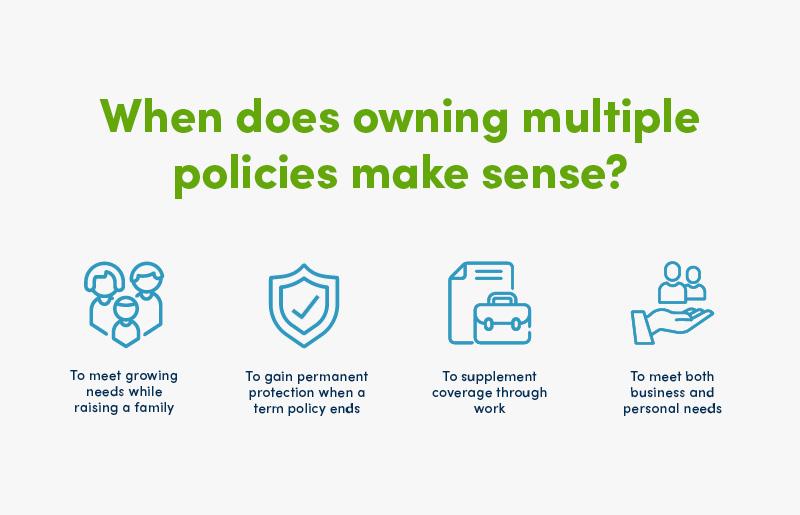Thinking about securing your family’s future and wondering if one life insurance policy is enough? You’re not alone! Many people ask, “Can you have multiple life insurance policies?” The short answer is yes — and there are some smart reasons why stacking policies might actually work in your favor. In this article, we’ll break down how having more than one life insurance policy can fit into your financial plan, what you need to consider, and how to do it the right way. Ready to get the full picture? Let’s dive in!
Table of Contents
- Understanding the Basics of Having More Than One Life Insurance Policy
- Why People Choose Multiple Life Insurance Policies
- How to Manage and Coordinate Your Life Insurance Plans
- Tips for Choosing the Right Combination of Life Insurance Coverage
- Closing Remarks
Understanding the Basics of Having More Than One Life Insurance Policy
It’s perfectly legal and sometimes even strategic to have more than one life insurance policy. Many people opt for multiple policies to cover different financial needs or life stages. For instance, one policy might be a term plan designed to cover specific debts like a mortgage, while another could be a whole life policy focused on long-term wealth transfer or estate planning. The key is understanding that each policy serves its own purpose and offers unique benefits tailored to your evolving financial goals.
Before acquiring multiple policies, it’s essential to assess your overall coverage to avoid unnecessary overlap and premium expenses. Keep in mind that insurance companies will evaluate your total coverage when underwriting new policies, so be honest about existing plans. Here are some quick points to consider:
- Financial justification: Ensure each policy has a clear role and justification.
- Affordability: Multiple policies mean multiple premiums, so budget accordingly.
- Disclosure: Transparently share existing policies during application to prevent claim issues later.
- Coverage limits: The total payout from all policies should align with your true financial needs.
Why People Choose Multiple Life Insurance Policies
People often opt for multiple life insurance policies to tailor their coverage to various financial needs and life stages. By holding more than one policy, they can diversify their protection strategies, ensuring that different financial obligations—such as mortgage payments, education costs, and retirement plans—are all covered. This approach offers flexibility, allowing policyholders to adjust coverage amounts without surrendering their original policies, which could have terms or benefits they still value. Additionally, multiple policies can be beneficial if a person’s health changes over time; maintaining an older, cheaper policy while acquiring new coverage at different stages creates a safety net against unexpected health shifts.
Moreover, having several life insurance policies can provide:
- Increased total coverage limits beyond what a single policy might allow
- The ability to separate funds for specific purposes, like estate planning or business continuity
- Flexibility in premium payments and policy terms based on individual budgets and needs
- Potential tax benefits by structuring policies in different accounts or trusts
Ultimately, multiple life insurance policies empower individuals to smartly manage their financial security, making sure their loved ones are well-protected regardless of changing circumstances.
How to Manage and Coordinate Your Life Insurance Plans
Juggling multiple life insurance policies can feel like a balancing act, but with a clear strategy, you can make sure each policy works harmoniously to protect your loved ones. Start by creating a comprehensive overview of all your policies, including coverage amounts, beneficiaries, premium schedules, and key terms. Maintaining an up-to-date spreadsheet or using specialized financial planning apps can simplify this process. This organized approach empowers you to see the full picture, preventing unnecessary overlaps or unintended gaps in your protection.
Coordination is key to maximizing your coverage without overspending. Consider these tips to manage your life insurance portfolio effectively:
- Consolidate where possible: Evaluate if combining policies through a single insurer or switching to a flexible policy makes sense for your situation.
- Communicate with beneficiaries: Keeping your beneficiaries informed about the details avoids surprises and ensures smoother claims.
- Review periodically: Life changes like marriage, buying a home, or having kids often call for updates to your coverage and beneficiaries.
- Consult a financial advisor: A professional can provide personalized advice to align your policies with your long-term financial goals.
Tips for Choosing the Right Combination of Life Insurance Coverage
When selecting the perfect mix of life insurance policies, it’s essential to align coverage with your unique financial goals and family needs. Start by assessing your overall financial picture—consider outstanding debts, future education expenses for kids, and ongoing living costs for dependents. This clarity helps in deciding whether term insurance for affordable, high coverage during critical years or permanent policies offering lifelong protection and cash value accumulation would work best for you. Remember, mixing different policy types can create a powerful safety net tailored specifically to protect what matters most.
Keep these key points in mind to make smart choices:
- Evaluate overlapping benefits: Avoid paying for redundant coverages that don’t add value.
- Check insurer policies: Some companies have limits on how much coverage you can have with them.
- Factor in costs: Balance your premium budget without sacrificing essential protection.
- Review regularly: Life changes fast—keep your coverage up to date with your circumstances.
Closing Remarks
And there you have it! Having multiple life insurance policies is definitely possible—and sometimes even a smart move—when done thoughtfully. Whether you’re layering coverage for different needs or supplementing an existing policy, just remember to assess your goals, stay within affordable limits, and keep all your beneficiaries in the loop. If you’re feeling unsure, don’t hesitate to chat with a financial advisor who can help tailor the best approach for your unique situation. Here’s to making confident choices that protect your loved ones—now and in the future! Thanks for reading, and stay protected!





